


Children across languages at around two years of age typically produce short utterances in which they frequently drop the subject noun phrase. English-speaking children, for example, very often produce subjectless utterances, such as
Languages differ with respect to how and whether subjects may drop (Soracea et al., 2013). In English, for example, there are contexts in which adult speakers can drop the subject due to topic recoverability. For example, as a response to
It is intriguing to note that very young children across languages start off by dropping the subject (e.g.,
1In this paper I have adopted Huang’s (1989) and Jaeggli & Safir’s (1989) original typological classification of pro-drop languages, namely that languages including Chinese and Italian are [+pro-drop] as in Korean and Japanese, and unlike in those [-pro-drop] languages such as English. Huang (1989) and Jaeggli & Safir (1989) do not agree with the view provided by one of the reviewers of this paper. This paper is in line with Huang’s and Jaeggli & Safir’s typological system for the sake of the development of its main ideas.
A number of studies have examined the production of subjects in children across languages and have suggested that development reflects sensitivity to informativeness, processing difficulty, or lack of grammatical knowledge. Greenfield and Smith (1976, p. 196) proposed that the most informative, easily recoverable content is likely to be omitted in early child speech, arguing that children’s single-word utterances, for example, express the most informative element. This view has recently been supported by Clancy (1993) who found that her Korean-speaking subjects (aged 1;8-2;1, 1;10-2;3) used overt subjects when queried for physically visible, or newly introduced information, but not highly predictable information. 2
Processing accounts such as Bloom’s (1990) assume that the length of verb phrase decreases as a function of the size of the subject. For example, long subjects (e.g.,
In contrast to the informativeness and processing accounts, Hyams (1994) provides a purely grammatical account, in which Italian and English are viewed as different language types. Unlike Italian, which has six differently marked forms of each verb (first, second, third person in singular and plural), English has only one affix inflected for main verbs, the third person singular suffix
None of these previous accounts, however, are solidly supported by recent findings. The informativeness and processing accounts, for example, would predict that children would drop subjects at a comparable rate universally at around 2;0. This prediction is not borne out. English-speaking children tend to drop subjects much less frequently than Italian- or Chinese-speaking children (e.g., 31% vs. 56%/70%), as reported in Valian & Eisenberg (1996). The grammatical account, on the other hand, would predict that English- speaking children would drop subjects at a lower rate than Italian-speaking children, but at a rate similar to that of Chinese- or Korean-speaking children. As expected, English-speaking children were observed to drop subjects much less frequently than Italian-speaking children (5%-31% vs. 70%) (Valian, 1991). Contrary to the prediction, however, as noted in Wang, Lillo-Martin, Best and Levitt (1992), Kim (1997), and Cho (2001), the rate of subject omission in younger English-speaking children was much lower than in Chinese- and Korean-speaking children (11%-31% vs. 56%/61%- 87%).
>
Subjectless Sentences in Korean
The cross-linguistic variations noted above perhaps should not be surprising. It may well be that language-specific properties beyond subject- verb agreement ultimately play an important role in the development of subjects. Unlike in languages like English, subjectless sentences in Korean are fully acceptable in adult constructions under either of two conditions, namely, topic recoverability and subject-modal agreement.
First, topic recoverability is a pragmatic condition implying that a subject can drop if its referent has previously been talked about, and is hence recoverable to the speaker and hearer (Givon, 1989, p. 216). In fact, the utterance
Secondly, a subject can drop in cases where its person feature (e.g., first (
For example, modals indicating speech acts such as stating intent and making proposals in a declarative statement may occur only with first person subjects. Modals expressing request and prohibition must co-occur with second person subjects. Other types of modals, on the other hand, are unrestricted, relatively free to occur with any person. Hence, the referent of the subject in Korean is potentially predictable due to the agreement requirement, and subjects can drop in competent adult sentences in Korean when this requirement is met.
Table 1 below presents a group of modal suffixes that are frequently used in adult speech and demonstrate person restriction in use. 3
[Table 1.] Speech act modal suffixes and person restriction of the subject in Korean
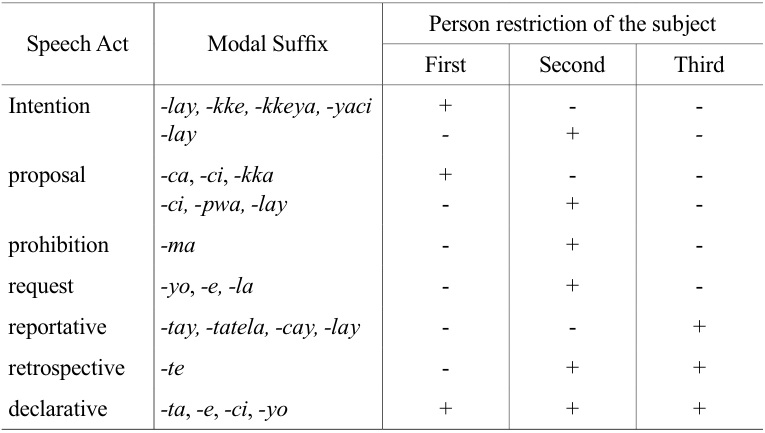
Speech act modal suffixes and person restriction of the subject in Korean
Given both topic accessibility and person-marked modality on verbs, it may be that, for Korean children, topicality and agentivity are more central notions encoded by the subject than for those learning other languages. It is argued that Korean children, unlike English-speaking children, presumably learn to use topicality and agentivity of noun phrases when choosing to report or not report the subject. Apparently, as reported in Choi (1997) and Clancy (1985), early speech act modals in Korean and Japanese children at around 1;8 include request, desiderative, and imperative, among others. As suggested in Rispoli (1995, p. 345), the early production of these modals may indicate children’s awareness of agentivity.
2Use of overt subject to refer to ‘physically visible’ referents is probably not typical of the adult system. 3Table 1 contains only those modals which occur relatively frequently in everyday speech. ‘-yo’ is an honorific form which can be added to almost all suffixes. ‘-lay’ can be used to denote the speaker’s intention in declarative statement, the interlocuter’s attention in interrogatives or in making a proposal.
The present study has two goals. One purpose is to examine the pattern of change over time in the production of null subjects, in topic recoverability, and in subject-modal agreement in the speech of two Korean children at several time points. For this purpose, two specific questions are asked, as follows: (a) What is the incidence of null subjects over time? (b) How do the Korean children mark modals on verbs over time?
A second purpose is to investigate whether topic recoverability and verb modality relate to null subject use in Korean children. While the major issue of this paper is change over time in child use of null subjects, I am also interested in looking into the development of the production of modals and sensitivity to topic recoverability, in light of the view that subject drop is potentially motivated by the grammatical and pragmatic conditions. I hypothesize that the frequency of null subjects will increase with age in cases where the referents are recoverable (old information) and predictable from the modals marked for particular person. Specific questions to be addressed in order to examine this hypothesis include: (a) What is the proportion of recoverable and non-recoverable topics in null and overt subject utterances in children? (b) How often are topic-recoverable referents encoded as null vs. overt subjects in children’s utterances with personneutral modals? (c) What is the frequency of person-specific suffixes in children’s null subject utterances and overt subject utterances? (d) What is the proportion of overt subjects in children’s total utterances with person- specific modals vs. those with person-neutral modals?
Participants were two Korean-speaking monolingual children, one girl (JW) and one boy (JK), and their mothers. They are from middle-class families and speak only Korean in the home. JK’s and JW’s ages on the first and last visit were 0;1 and 3;0, and 2;0 and 3;30, respectively.5
During each visit mother-child dyads were audio-taped for an hour by a fluent speaker of Korean. The visits were spaced approximately two weeks apart and the parents were asked to do whatever they would normally do at that time of day. Studies report that children normally begin producing words at around 1;0 and increasing their verbal productivity at around 1;6, and begin producing multi-word utterances after 2;0. It was observed that JK did not begin to produce subjects overtly and productively until 1;7. The present study thus focuses on the children’s language development from 1;8 and every four months thereafter to 3;0.
*MOT: iken mwe-ya? (What’s this?)
*MOT: iken mwe-ya? (What’s this?)
*CHI: emma camba. ((It’s) Mom’s jacket.)
%sub: $ns
%top: $old
%suf: $nsf %per: $3
*MOT: emma camba-ya? (‘(Is it) Mom’s jacket?’)
*MOT: engtheli-ney. (‘(It’s) a fake.’)
*CHI: ike emma os. (‘(It’s Mom’s clothese.)
%sub: $os
%top: $nid
%suf: $nsf
%per: $3
(JK 2;4.5)
All overt subjects that co-occurred with a verb were counted. The analysis also included all verbs that were used in isolation, yet produced clearly in relation to a noun phrase functioning as a subject in the sentences containing them. In addition, I also coded all overt noun phrases that occurred alone without a verb in cases where they clearly encoded subjecthood. The following types of utterances were excluded in the analysis: repetitions of immediately preceding utterances of the child’s own and his/her caretaker’s ($rpt), unintelligible ($nid), utterances with no direct relevance to the present study ($irr) (e.g., exclamations, greetings, responses to yes-no questions (e.g.,
The analysis further included a set of data collected during a one-hour- long interaction between JW at 3;0 and her mother in a natural setting in order to examine adult Korean usage of subjects and modals to be obtained. This set of maternal data was coded using the same coding features employed in the analysis of the speech of JK and JW.8
Reliability of each coding system was assessed on 15% of the data. Two trained coders coded each type of subject, the topic, the modal, and person in the randomly chosen transcripts representing a range of ages and levels.9 The percentages of agreement between the two coders for the codes were computed, and reliability was further assessed by calculating Cohen’s kappa, a measure of inter-coder agreement that corrects for chance. Based on Bakeman and Gottman (1997, p. 66), it was assumed that a kappa of .7 or greater is large enough to conclude that the agreement is significantly better than chance. The raw percentage of agreement between the two coders was 92%, and the Cohen’s kappa was 77%.
The proposed codes were analyzed for the purpose of examining the pattern of change over time in Korean children’s production of null subjects, in relation to topic recoverability and to subject-modal agreement.
Results are reported here in two parts. First, for the first descriptive purpose of this research, results are presented on the proportions of utterances with null subjects and those with verb modal suffixes in each of the two Korean children at four different time points. For the second goal of this paper, the percentages of the null subjects at each time point for each child in contexts involving recoverable topics and person-specific modals were calculated. For these analyses I used the COMBO program within CHILDES (MacWhinney, 1995) to calculate the co-occurrence of null subjects and recoverable topics, and null subjects and person-specific modals. This analysis will allow us to examine shifts over time in the percentages of the null subjects referring to recoverable topics and those co-occurring with person-sensitive modals. In order to investigate whether child use of null subjects is associated with topic recoverability or modality marking, I will observe the main findings for the two children at each time point and analyze similarities and differences.
4I agree with one of the reviewers of this paper that we may likely lose a number of important pieces of evidence concerning the development of language in the speech of youngest children in particular. I hope that I will soon be able to conduct an analysis of a greater number of utterances that I have collected every week so that I can include as many crucial examples as possible in my future research. I would like to thank the reviewer for making the tremendously important observation and suggestion. 5MLU was not estimated in the present analysis. It was, in fact, not possible to measure it because I used the Korean alphabet in transcribing the children’s utterances without morphemicizing them and could not get CLAN (MacWhinney 1995; 2014) to estimate it. JK was 0;1 when he began to be observed and taperecorded while interacting with his mother, grandmother, and nanny. His mother was a developmental psychologist and took notes about details concerning JK’s verbal and non-verbal behavior during each session of taping. For the purpose of this study, I focus on JK’s speech taped from 1;8 on because he did not begin producing multi-word utterances until after around 1;6 years of age. 6The following abbreviations are used in the data: MOT=mother’s speech, CHI=child’s speech, sub=subject, ns=null subject, os=overt subject, nid=nonidentifiable, per=person, 1/2/3=first, second, third person feature, top=topicality, old=old (given) information, suf=suffix, nsf=null suffix. I am a native speaker of Korean, so I did not include English translations in my coding system. For the benefit of non-Korean speakers, however, I added them in this paper. Korean examples in this thesis are transliterated on the basis of Yale Romanization Systems in Martin and Lee (1969, p. 575). 7I borrowed the expression ‘set phrase’ from Kim (1997, p. 417). 8One of the reviewers of this paper suggested that ‘examine’ should be changed into ‘ascertain.’ I am grateful to the reviewer for the suggestion. I would like, however, to use the same verb ‘examine,’ in light of the fact that, until after a final analysis will have been conducted, we will not be able to ‘ascertain’ anything about adult usage. 9I would like to thank Hyunsoon Chae and Kyungsook Shin for their help in assessing reliability of my coding system.
To begin, let us observe an overview of the frequency of all types of utterances found in the speech of JK and JW, as in Table 2 and Table 3 below.10
[Table 2.] Frequency (Proportion) and types of utterances in JK at 1;8 - 3;0
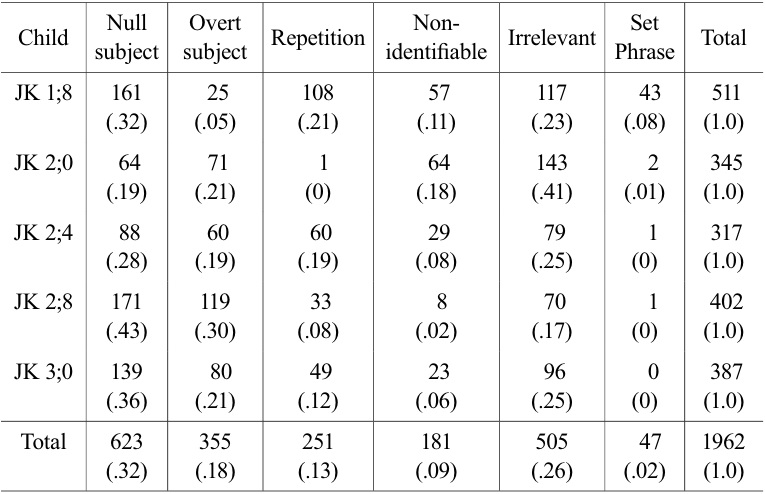
Frequency (Proportion) and types of utterances in JK at 1;8 - 3;0
[Table 3.] Frequency (Proportion) and types of utterances in JW at 2;0 - 3;0
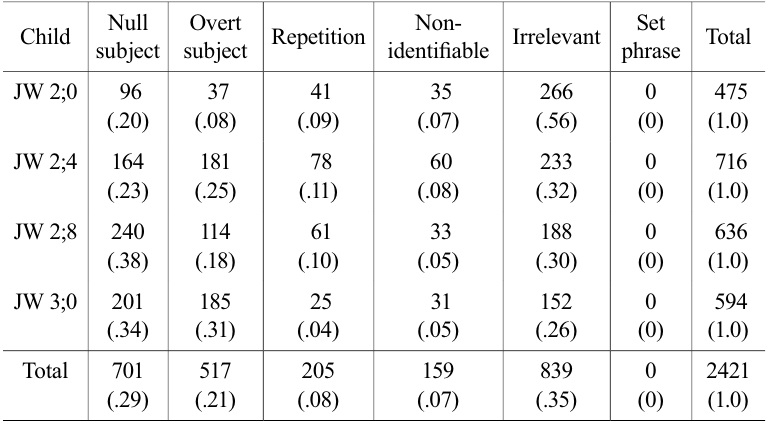
Frequency (Proportion) and types of utterances in JW at 2;0 - 3;0
As seen in Table 2 and Table 3, on average, approximately 50% of the child utterances included null and overt subjects. The rate of null and overt subjects has a tendency to increase with age while the total frequency of other types of utterances including repetitions, irrelevant and non- identifiable productions, and set phrases decreased with age.
In this section we are concerned with subject use in the speech of JK and JW. A preliminary analysis of JK’s early production data indicated that no overt subjects began to emerge until around 1;6. At 1;7.16 he was observed to start using subjects productively although they were frequently associated with just a few referents such as his caretakers (
>
Development of Topic Recoverability
What was the overall frequency of both recoverable (old) and nonrecoverable (new) topics in null and overt subject utterances in JK and JW at 1;8-3;0? I coded each subject noun phrase as “old” if the referent had been mentioned in the immediately preceding clause, or was present physically in the discourse context. Thus, not only the physically accessible objects, but also all first and second person referents (speaker and his/her interlocuter) were included in the “old” category. The “new” category, on the other hand, included any subject referent being mentioned for the first time. An examination of the rate of old and new topics in null and overt subject noun phrases will help to explore how the production of subjects relates to change in recoverability of topic.
>
Use of Subjects and Topic Recoverability
First of all, in Table 4 and Table 5 we examine the occurrences of subjects produced by JK and JW at 2;0–3;0, and explore how often old referents were expressed as a null and an overt form.

Frequency (Proportion) of old referents in null and overt subject utterances in JK at 2;0-3;0

Frequency (Proportion) of old referents in null and overt subject utterances in JW at 2;0-3;0
In Table 4–Table 5, we can observe that old referents were expressed more frequently with null subjects than with overt subjects by both JK (67–90% vs. 10%-33%) and JW (58–84% vs. 16–42%) (see also Table 5 and Table 6).
[Table 6.] Frequency (Proportion) of new referents in null and overt subjects in JK at 2;0-3;0

Frequency (Proportion) of new referents in null and overt subjects in JK at 2;0-3;0
Let us now examine in Table 6 and Table 7 how often new referents were conveyed by null and overt subjects in the speech of JK (6% vs. 94%) and JW (9–91%).
[Table 7.] Frequency (Proportion) of new referents in null and overt subjects in JW at 2;0-3;0

Frequency (Proportion) of new referents in null and overt subjects in JW at 2;0-3;0
The findings above indicate that both children often failed to provide an overt subject in referring to new information although the erroneous subject drop mostly occurred at 2;0 in JK (11%) and in JW (28%) and was rare at all other time points (4–7%). Notice that the error rate dropped at 2;4 from 28% down to 7% and from 11% to 0–9% in the speech of JW and JK, respectively.
The results in Table 4–Table 7 clearly demonstrate that both JK and JW preferred producing null subjects to convey old information and overt subjects to introduce new referents. As mentioned in the beginning of this paper, topic recoverability in Korean is a pragmatic condition that allows, but does not require a subject to drop if its referent has previously been talked about. Hence, children’s use of overt subjects in contexts involving an old referent (10–33% in JK and 16–42% in JW) is not seen as erroneous. It is important, on the other hand, to make two observations. First, as seen in Figure 2, JK and JW referred to old referents with overt subjects less often than with null subjects. Second, as shown in Figure 3, as they got older, both children both began to correctly use overt subjects to denote new referents with a higher rate than they erroneously dropped them. The chi-square statistic was computed to determine whether the frequencies of old and new referents are related to subject type. It was found that subject use is likely to be associated with topic recoverability in JK (χ2 =288.522, p<.001, df=1) and JW (χ2 =276.69, p<.001, df=1).
>
Development of Subject-Modal Agreement
This section is concerned with how children develop modal suffixes and subject-modal agreement. Both JK and JW produced modal suffixes in all of their utterances containing a verb at every time point, and it was thus not possible to examine how these children initially began to use modals on the verbs. In this section we focus our discussion on the development of modal type and subject use in the two children’s utterances with a verb.
How frequently did JK and JW produce person-specific vs. person-neutral modal suffixes in their total utterances with verbs? In Table 8, we can note that for JK the proportions of utterances with person-specific modals are lower than those with person-neutral modals.
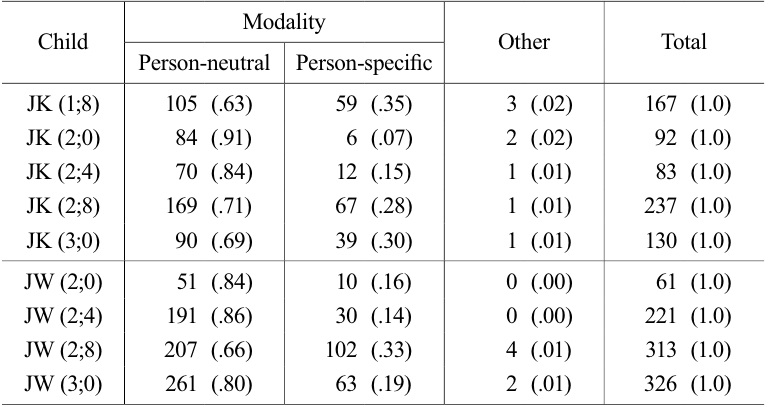
Frequency (Proportion) of person-neutral and person-specific modals in the utterances with verbs in JK at 1;8-3;0 and JW at 2;0-3;0
For JK, the proportions of utterances with person-neutral modals are also greater than those with person-specific modals. The specific proportions shift at each time point presumably because modal use relates to intent and may be sensitive to speech context (e.g., specific activity, conversation topic, etc.), and may not necessarily reflect development.
A close look at the occurrences of person-sensitive modals reveals a few interesting features for JK, in particular. The proportion of person-specific modals was larger at 1;8 (35%) than any other time points examined. The frequency dropped to 7% at 2;0 and 15% at 2;4. This type of change was not found for JW. A closer investigation of the 59 occurrences of the modals produced at 1;8 in JK points to a possibility that his production of the modal suffixes is not contrastive.
The use of a modal suffix can be contrastive in two ways as follows. For one, it is thought that a suffix (e.g.,
At 1;8, JK began to use two different modal forms,
Along similar lines, contrastive use of modals did not emerge until around 2;4 for JW, while the instances of these suffixes before 2;4 were not as frequent as for JK (35% vs. 16%). The proportion of utterances with personspecific modals for JW at 2;4 and later tended to increase with age with a range from 14% to 33%. For example, as will be seen in Table 7 below, modals marking requests and proposals started to be used more frequently at 2;4 than at 2;0. An examination of the instances of these modals indicates that they were expressed contrastively in two forms,
>
Use of Subjects and Person-Specific Modals
As briefly mentioned earlier, a subject can drop optionally in Korean in cases where its person feature (e.g., first (
To begin, let us first look at the overall proportions of null subject utterances with person-neutral and person-specific modal suffixes for JK and JW at 2;0-3;0 in Table 9.
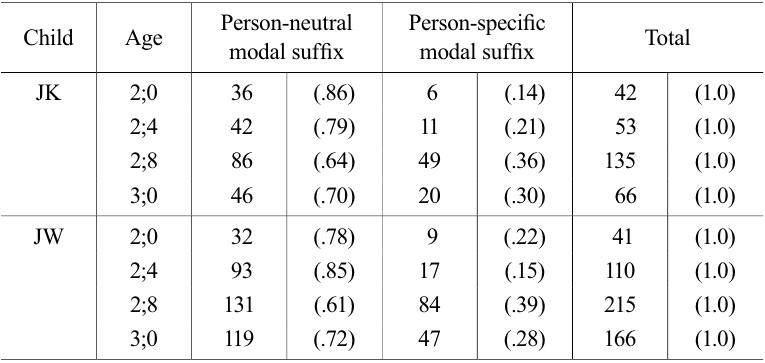
Frequency (Proportion) of person-neutral and person-specific modal suffixes in null subject utterances containing a verb in JK and JW at 2;0-3;0
We can see in Table 9 that for both children the frequency of person- specific modals in such null subject utterances increased over the first three time points from 2;0 to 2;8 and then decreased somewhat from 2;8 to 3;0. It is important to notice that, as seen in Table 10 below, the frequency and the type of person-specific modals increased from 2;8 on in both children’s null subject utterances containing a verb. We can note that the modals denoting intention, proposal, and request, in particular, were used more frequently at 2;8 and at 3;0 than the earlier time points in the speech of both JK and JW.
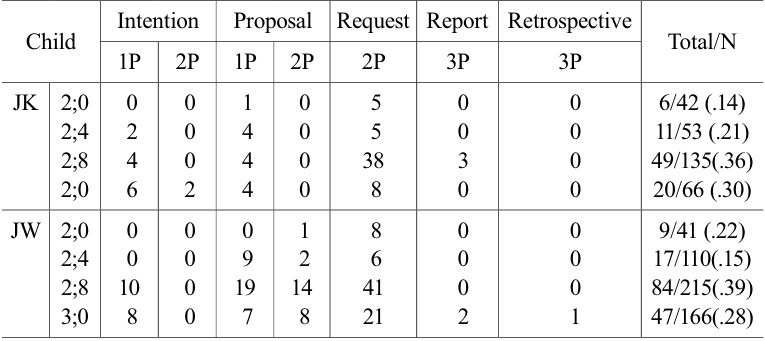
Frequency (Proportion) of person-specific modal suffixes in null subject utterances containing a verb in JK and JW at 2;0 - 3;013
Now, let us observe in Table 11 below how often overt subjects co-occurred with person-specific modal suffixes.
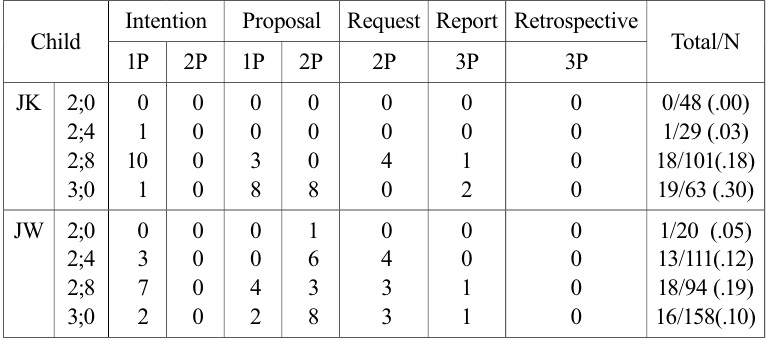
Frequency (Proportion) of person-specific modal suffixes in overt subject utterances containing a verb in JK and JW at 2;0 - 3;0
Note in Table 11 that both JK and JW began to use person-specific modals more frequently at ages 2;8 than the earlier time points (3% vs. 18–30% in JK and 5–12% vs. 19% in JW), and, as in Table 11, modals encoding intention, request, and proposal were produced more frequently at 2;8 and 3;0 than the earlier time points.
Given the findings in Table 7–Table 11, we can observe that the rate of person-sensitive suffixes was higher in null subject utterances than in overt subject utterances across time points in the speech of both children. The chi-square statistic was computed for each child to determine whether the frequencies of person-neutral and person-specific modal suffixes were the same regardless of the type of utterance they occur in (with overt or null subjects). It was found that the frequencies of verb modality are likely to be related to the type of subjects for JK (χ2 =7.58, p<.01, df=1) and JW (χ2 =36.92, p<.001. df=1).
>
Use of Subjects and Person-Neutral Modals
We have just seen that person-sensitive modals were used more frequently in null subject utterances than in overt subject utterances. It is of interest in this section to examine how modal marking is related to children’s use of overt subjects. It is speculated that, if modal marking is related to children’s use of subjects, it is likely that subjects are realized overtly in their utterances with person-neutral modals. As noted earlier, person-neutral modals report neither the agent nor the intended speech act, and it is thus likely that subjects are used overtly with the verbs containing such suffixes if children are sensitive to subject-modal agreement. Let us now examine in Table 12 how often an overt subject was expressed in children’s utterances with person-specific modals on one hand, and in those with person-neutral modals on the other.
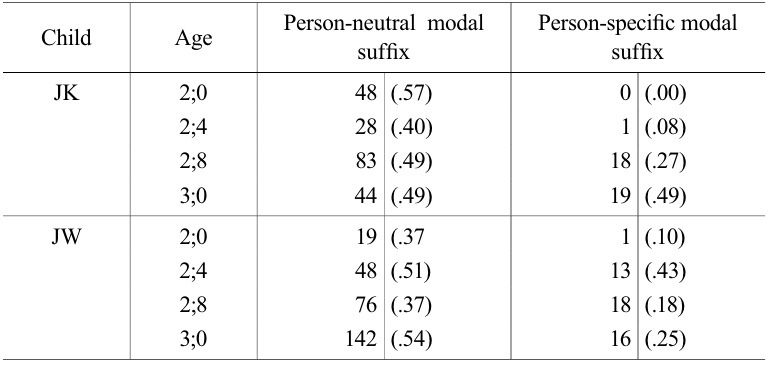
Frequency (Proportion) of utterances with person-specific and person-neutral modals in which a subject is provided in JK and JW at 2;0-3;0
An overall observation of Table 12 indicates that, in the speech of both JK and JW, subjects were used overtly with a higher rate when co-occurring with person-neutral modals than with person-specific modals (37–57% vs. 0–49%). A higher proportion of person-neutral modals in overt subject utterances is consistent over all four time points in the speech of JW and the pattern was also observed in JK’s earlier utterances. Toward the end of 3;0, JK used overt subjects at a gradually increasing rate in the utterances with person-specific modals, reaching the level as high as the proportion of overt subjects in those with person-neutral modals (49%). The high proportion of the overt subjects in the utterances with person-specific modal suffixes in the speech of JK at 3;0 would be surprising if subject use were motivated by modality type alone. In Korean, a subject may be reported in contexts where it is focused, contrastive, or emphatic, irrespective of the type of modal suffix used in the utterance containing it. A close examination of all nineteen overt subjects with a person-specific modal suffix in JK’s speech revealed that seven instances of the overt subjects conveyed focused and emphatic information while six of these seven occurrences all were topicrecoverable. This observation suggests a possibility that JK was probably developing sensitivity to the effect of discourse prominence involving focus and emphasis in addition to modality effect on determining the type of subject to be produced.
We have just seen above that person-neutral modals were used more frequently in utterances with overt subjects than person-specific modals. This suggests that children tend to express a subject overtly when its co-occurring modal suffix provides no information encoding person specification. As discussed previously, however, subject use is influenced not only by subject-verb agreement, but also by topic recoverability condition, and it would be worthwhile to investigate how topic recoverability influenced children’s use of overt subjects in their utterances containing person-neutral modals. Observe Table 13 on this regard.
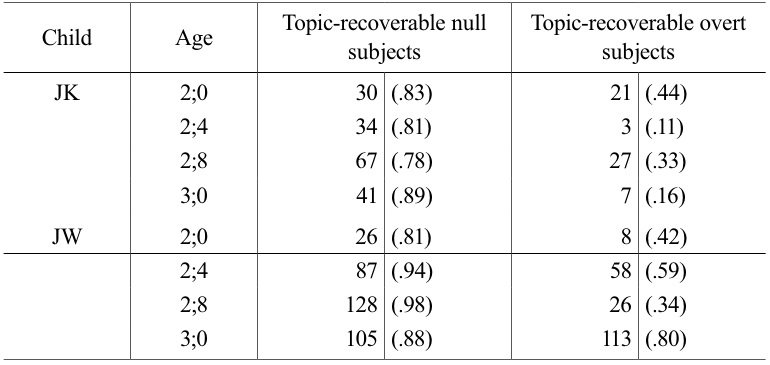
Frequency (Proportion) of topic-recoverable null vs. overt subject utterances with person-neutral modals in JK and JW at 2;0-3;0
Table 13 shows that from 2;0 to 3;0 both JK and JW dropped a subject more frequently than they retained it in their utterances with person-neutral modals when the subject was associated with topic-recoverable information in their utterances with person-neutral modals. Overall, a preference for null subjects in such topic-recoverable utterances is observed consistently although JW increased her proportion of overt subjects in such contexts toward the end of 3;0. All 113 occurrences of topic-recoverable overt subjects in JW’s utterances with person-neutral modals were analyzed in terms of discourse notions, and it was found that 37 of these instances referred to the object of focus, emphasis, and contrast. This probably reflects the child’s growing attention to these additional communicative functions encoded by an overt subject as in adult speech.
10‘Null subjects’ include lexical nominals and pronouns. 11As noted in Choi (1995, p. 171), ta and ney convey a slightly different epistemic content in adult speech. While ta and ney both express new information, ney is likely to be used more frequently than ta to indicate that the information has been perceived by the speaker, in particular. This is an extremely subtle difference, and it is not absolutely clear that JK was sensitive to this contrastive use of declarative modality because it was still fairly rare at this stage. 12In Table 9 and Table 10, I deliberately excluded the occurrences of personspecific modals in JK at 1;8 due to his extremely conservative and non-contrastive strategies in his uses. I included, however, his data at 2;0 and on, so that it can be compared with JW’s for the purpose of this section. 13The person features in Table 9 and Table 11 indicate person restriction in use of each modal. The present analysis excludes the instances of modals associated with phrasal and clausal conjunctions (-ko (‘-and’), -se (‘-because’), -ttay (‘-at the time when’), -myense (‘-while’),-nikka (‘-because’), -to (‘-although’), and non-identifiable occurrences. In this paper I did not examine the subject identity requirement between main clauses and embedded clauses in Korean. Clausal conjunctions like –myense (‘-while’) and –camaca (‘-as soon as,’ for example, require identity between the main subject referent and the embedded subject referent. These kinds of conjunctions did not occur frequently for JK and JW in this age span.
This study had two goals. One was to examine the pattern of change over time in the production of null subjects as related to subject-modal agreement and topic recoverability in two Korean monolingual children at several different time points. Another purpose was to determine whether change in topic recoverability and verb modality relates to null subject use in Korean children. A summary of the main findings of the present study follows.
First, with regard to the rates of null subjects and subject-modal agreement, I focused on the speech of JK and JW from 2;0 to 3;0, while setting aside JK’s utterances collected at 1;8, because, as noted earlier, JK’s use of modal suffixes at 1;8 did not seem to be productive and it was difficult to determine whether there would be any relationship between his use of person-specific modal suffixes and his null subject use. It was found that in the speech of both children from 2;0 to 3;0 the same pattern of increase and decrease was observed in children’s use of person-specific modal suffixes in their null subject utterances containing a verb. That is, while the two children generally increased their use of subjects with age from 2;0 on, they produced null subjects in utterances with person-specific modals increasingly from 2;0 to 2;8, although somewhat less frequently from 2;8 to 3;0. The decrease in use of null subjects at the later time points may reflect children’s growing sensitivity to the pragmatic function of overt noun phrases to express topic focus and a contrast in conversation. This possibility is reminiscent of a previous study by Lee (1999) who has noted a few instances demonstrating that some children begin to express contrastive and focal referents correctly before 2;0, reporting that the ability to use a noun phrase to encode a contrastive topic largely develops toward the end of the null subject stage. Overall, my study indicated that personspecific modal suffixes were produced more frequently in null subject utterances than in overt subject utterances, and thus it was concluded that the production of person-specific modals is likely to be associated with the subject type.
Secondly, it was observed that null subjects in both children’s speech served to encode old referents at a greater rate than new referents, and thus it was concluded that topic recoverability relates to null subject use.
As noted above, subject drop in the speech of JK and JW decreased with age, yet continued to occur in over 50% of their utterances at age 3;0. This figure is similar to a subject drop rate obtained in other studies of children learning Korean and Japanese. Kim (1997) and Cho (2001) found that Korean subjects (2;0–3;0) employed null subjects at a rate of 50–60% on average.14 Wang, Lillo-Martin, Best, and Levitt (1992) also found that Chinese children aged 2;0 and 4;4 employ null subjects at the rate of about 53% of the time. This is in sharp contrast with the figures reported for the speech of children speaking other languages such as English. Valian (1991, pp. 44–45), for example, found that her younger subjects (1;10–2;2) deleted a subject at a rate of around 30% on average, and the rate continued to drop down to 2% in older children (2;3–2;8).
The cross-linguistic data reported above reveals two facts: (a) children across languages all start out by dropping subjects; (b) the null subject rate in children speaking different languages varies. Recent theories of null subjects in child language have centered around two types of considerations, processing limitation and typological variation, as follows.
With respect to subject drop at the earliest phase of development, Bloom (1990) proposes that younger children fail to produce subjects because they have difficulty planning and producing multi-word utterances. Apparently, Bloom found that the verb phrases in subjectless sentences in three English- speaking children tended to be relatively long. This processing account was challenged by Hyams and Wexler (1993). They argue that the account does not explain why it should be the initial position of a sentence that burdens the processing load.
The processing account does not seem to provide an adequate explanation for subject use by JK and JW. As noted previously, like other children JK and JW frequently omitted subjects at the earlier time points. Importantly, on the other hand, it is worth remembering not only that neither completely stopped deleting subjects when they got older, but also that they both continued to provide a subject to encode old and new referents. Based on Bloom, it seems difficult to understand why both JK and JW produced null and overt subjects concurrently and why they selectively used subjects to express old information, instead of simply dropping them, even at the earlier stages of development.15
Unlike the accounts based on processing deficit, the grammar-based account stems from a typological variation found in different types of languages. According to Hyams and Wexler (1993), languages may be classified into the Italian-type and the Chinese-type. Italian-type languages such as Italian and Spanish employ a relatively rich set of verb inflections involving person and number agreement, and the referents of null subjects can be recovered through the information provided in the rich inflections. In sharp contrast, languages like Chinese lack person and number agreement and null subjects can be identified only with the help of information like the discourse topic. In accordance with these typological criteria, it is assumed in this theory that both English and Korean are more likely to be a Chinese-type language than an Italian-type because, as described in the literature, neither employs an inflectional system as rich as Italian or Spanish (Hyams, 2012).
The grammar account is challenged by the main findings of the present study. This account predicts that English-, Chinese-, and Korean-speaking children should resemble each other in the rate at which they drop subjects because their languages are similar typologically since none employs a morphologically uniform verbal agreement paradigm like Italian. This prediction is, however, not borne out. As seen above, subject drop rate in children learning Chinese and Korean appears similar (47–68%), but it is far lower in English-speaking children (2–30%). Italian-speaking children studied by Valian (1991) were observed to delete subjects about 70% of the time on average, at a rate similar to the frequency found in Korean- speaking children. The lower rate of subject drop in English-speaking children on one hand, and the higher drop rate in both Italian- and Korean- speaking children on the other, should not occur if the grammar account were correct.
Perhaps the serious problem for the grammatical account is its failure to classify Korean properly typologically. In fact, on the basis of the morphologically uniform verbal agreement paradigm alone, it is difficult to identify the typological status of Korean adequately. As pointed out above, Korean is similar to Chinese in light of the fact that null subjects in these languages are licensed by topic recoverability. Korean, on the other hand, is like the Italian-type, in that it makes use of a set of affixes encoding modality, honorificity, and plurality on the verb, which are required to agree with a co-occurring subject in person and number.16 Thus, Korean is a mixed type, partly like Italian as well as like Chinese; the grammatical account offered by Hyams inadequately classifies which type of language Korean may be typologically and fails to predict how its subject rules are acquired.
14In fact, Kim (1997, 420) reports on the proportions of overt subjects in her three Korean-speaking subjects. I took the liberty to estimate the rate of null subjects based on her figures of overt subject rate. 15As correctly pointed out by one of the reviewers of this study, the present study has no evidence regarding sentence length and thus has no direct counter-evidence against Bloom’s processing account. This study, however, is in line with the approaches developed in Allen & Schroeder (2003) and Gürkanli et al. (2007), in which the processing account is disconfirmed by their evidence demonstrating their subjects’ pragmatic skills as found in the Korean subjects as in this study. 16The affixes encoding plurality and honorificity are –tul and –si, respectively. They are not speech act modals so were not covered in this study. In fact, neither affix was observed to occur in the speech of JK and JW.
To conclude, the main findings of this study suggest that the acquisition of null subjects in Korean is facilitated both by children’s early sensitivity to topic recoverability at the earliest stage of development and by their gradual development of modals and subject-modal agreement. As seen in this paper, it was found that in the speech of both JK and JW, topic recoverability was related to null subject use from the earliest stage on, and that person-specific modality marking was also associated with null subject use.
The main findings of this study strongly suggest that at around 2;0 Korean children are able to distinguish old and new information, and drop or overtly report the subject accordingly. Our data also demonstrate a possibility that two-year-old Korean children gradually become sensitive to the connection between modal suffixes and the subjects that agree with them. As observed earlier, one important feature of the acquisition of modal suffixes in JK and JW was early production of imperative, request, and desiderative modal suffixes, in particular, before other modals are reported, and sensitivity to the subject-modal agreement manifested gradually at later time points.
It is speculated that, along the lines suggested in Rispoli (1995, p. 345), Soracea et al. (2009), and Shin & Ecker (To appear in 2015), pragmatics on one hand, and speech act and inflectional morphemes on the other are possible information sources for the construction of the relation between the meaning of predicates (e.g., pushing, being affected, etc.) and the discoursepragmatic and syntactic roles encoded by a subject (e.g., agent, patient, etc.). Assuming that Korean involves both a pragmatic and a grammatical condition and that children begin by talking about various real-life scenes primarily socio-pragmatically (Rispoli, 1991; Tomasello and Brooks, 1999; Snow, 1999), it is proposed that language typology effects should be both grammatical and pragmatic, and that the role of pragmatics must be explored in the emergence of grammar.17
In closing, it is hoped that this study will help us understand how children’s socio-pragmatic awareness and grammatical competence are integrated in children’s language development in Korean. Such knowledge can help us understand better the relationship between pragmatic and grammatical development. It will also be of interest to xplore whether the children approach the Korean adult level in their use of subjects and modals. This will be important in light of the possibility that, as discussed earlier, a subject drop in Korean is facilitated by predictability of its person feature from the modals affixed on its co-occurring verb, unlike in other languages such as English. A future study on ellipsis in the speech of Korean-speaking adults will possibly provide an insight into this inquiry.
17One of the reviewers of this paper argues that the main findings of this study are in support of Hyams' (1986, 1993, 1994, 2012) prediction. I would like to make it clear repeatedly that Hyams’ hypothesis is crucially based on the parameter theory in which purely syntactic notions such as government, C-command, and subjectobject asymmetry, among others, play a major role in the account of anaphora, and has no bearing on this paper in which we have seen evidence against the parametric view of Korean ellipsis. For this reason, it is clear that whether Hyams’ prediction can provide an account of the main findings of this present study is beside the point.













